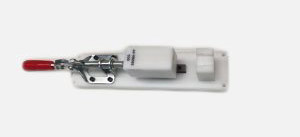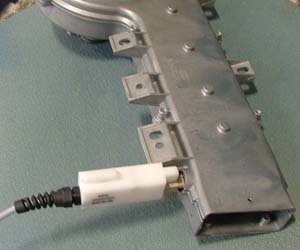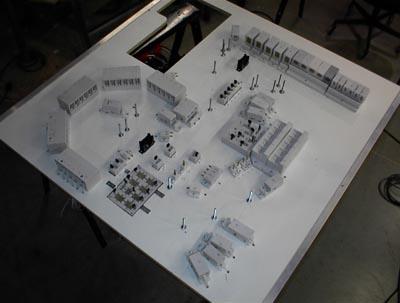Wire Harness Testing Evolution
The Advent of Test Fixtures
Increasing demand for accelerated error free production of wire harness has impacted every area of the process. Testing is no exception. Once a slow and simplistic manual point to point operation, testing has now become a sophisticated, computerized and efficiency focused process that is expected by the end customer.
Harness manufactures traditionally have used mating connectors to facilitate testing. Locking tabs would be removed where possible to speed engagement and disengagement. The fact that some connectors do not have mates presented special challenges as some are designed to mate into an ECU or other electrical devices which are of no help when performing a continuity test. The repetitive engagement of housings and terminals would quickly cause wear and require frequent replacement. Generally speaking, terminals are designed for very few engagements and may only be engaged once or twice throughout their lives in the field. The mating of the terminals in some instance would impact their integrity and lead to failures in the field. Visual inspection was required for critical items such as secondary locks, clips and seating of terminals.
Spring Probe Technology and the Emergence of Test Fixtures
In the effort to speed processing and improve quality, test fixturing has taken hold across the wire harness industry. The benefits are two-fold: ease of use for the operator; less of a maintenance headache for the personnel that support the testing function.
The introduction of spring probe (pogo pin) technology has driven this movement (Fig. 1). The spring probe allows the light engagement of the terminal to perform the continuity test without violating the integrity of the terminal and introduces very little resistance into the electrical test. Basic continuity testing is typically done with probes that exhibit only a few ounces of spring force. Test probes are manufactured in many different standard diameters with a wide range of tip options that are effective for engaging the varied sizes and shapes of connector terminals. Some tip styles are designed to cut through dirt or oil to ensure consistent, solid contact. The fixture manufacture should select the most appropriate size and tip style for the individual application. The mechanical life of spring probes is typically 1,000,000 to 2,000,000 cycles. Spring probes are usually designed to be used in conjunction with a receptacle (sleeve). Lead wires are attached to the sleeve and are interfaced back to test equipment. Probes can be friction fit into sleeves or threaded into sleeves. Both sleeve options allow for quick changeability.

These test probes are incorporated into a designed housing structure that acts as the mating connector and will be keyed to only accept the connector in the proper mating orientation (Fig. 2). The housing will also incorporate a retention mechanism that makes it very easy for the operator to insert and remove the connector. The material that is used in the test fixture housing is generally some type of non-conductive plastic. Delrin is a widely used material across wire harness production testing and automotive functional testing, but some cast plastic materials are also found to be both cost effective, durable and less moisture absorbent. The durability of the selected material should always be considered in respect to volume of testing.

Fixtures can also be designed to test for the presence of other connector and wire harness components such as secondary locks and clips. These features can be incorporated cost effectively through the use of switch pins that engage the components to verify their presence (Fig. 3). Switch pins look similar to spring probes. The difference is that current passes immediately through a spring probe upon contact, whereas the current only passes through the switch pin when it compresses and reaches its switch point. A wire is attached to the barrel of the switch pin and another is attached to the stem coming out of the back end. The stem is insulated from the barrel. The two come into contact when the switch pin compresses to the switch point. The circuit closes between these two points if the lock or clip is present. It remains open if they are missing. The switch is wired and programmed into the test sequence like any other circuit.

Don’t Sweat the Small Stuff
Ring terminals, spade terminals, insulated and uninsulated male and female fast-ons and flag terminals, blunt cut wires, stripped, partial stripped, and terminated wires are all common on harnesses. Test fixtures of differing varieties have been developed for all of them.
A ring terminal fixture can consist of a simple plastic base with a metal stud machined to the inside diameter of the ring terminal. If both the ID and OD need to be verified, a plastic stud can verify the ID and a plastic shroud can surround the OD while spring probes contact the underside of the ring terminal (Fig. 4).

Insulation piercing clips can be used to test wires, or fixtures with properly positioned contacts can test blunt cuts or stripped wires of different sorts without impacting the insulation.
Spring probe constructed fixtures will effectively contact straight fast-on terminals and flag terminals without violation and simple clips can be used to secure and test spade terminals (Fig. 5).

The Unseated Terminal
Issues with unseated terminals have plagued the industry for years. Most connectors are push to seat and operators are trained to push-click-pull. But the repetitive nature of the process and the quest for speed can lead to errors. While some connector designs lend to easy seating, others can be more challenging and error prone. During the testing process, terminals that are barely not engaged can make contact and pass the continuity test. The challenge for manufactures is to catch these instances.
The most simplistic and least costly approach as it relates to test fixtures is to set the depth of the probes in the fixture to allow minimal engagement with terminals that are fully seated. Typically probe manufacturers will recommend travel/engagement of 2/3rds of the probes full travel. By limiting the engagement, most cases of unseated terminals may be detected as open circuits.
In the testing of connectors with female terminals, a type of probe called a “Hat Pin”, “Shoulder Pin” or “Step Pin” (Fig. 6) can be used in many instances to limit engagement with a fully seated terminal. These spring probes have a shoulder that stops on the face of the connector housing (with Deutsch DT04 and DT06 series connectors and their Amphenol and Molex crosses, the shoulder stops on the wedge). The dimension of the probe from its shoulder to the tip of the probe controls how much engagement is made with the terminal. These types of probes are slightly more expensive than standard spring probes and are a cost-effective approach to controlling the amount of engagement.

A third and more costly approach would be to test using heavy pressure switch pins rather than a spring probe (Fig. 7). The heavy pressure switch pin can push the unseated terminal back, and though making contact will not pass the current because it has not compressed to its switch point. Conversely, if the terminal is seated the switch pin engages, compresses to its switch point and passes the current. It allows the for a concurrent continuity test and terminal seating test. This can also be done as a stand-alone terminal seating test which would require a continuity test later in the process. The number of positions and the spring pressure involved will usually necessitate the incorporation of a clamp and a mechanical slide to assist the operator with engagement.

While no approach may catch every instance of an unseated terminal these will work toward the mitigation of these errors.
Connector Housings that Accept Male and Female Terminals
Some connector housings are designed to accept both male and female terminals. This can present special challenges for the manufacturer in insuring that the proper sexed terminal is delivered to the customer. In some cases, special probes that have an insulator set either in the center or around the outside can be used to read a male terminal only or to read a female terminal only.
Locking and Marking
In order to prevent bad harnesses from being passed on to the customers, manufacturers may choose to add a locking feature to one of the fixtures used to test the harness. Once engaged and locked in place, the operator is unable to remove the wire harness (Fig. 8). When the testing process is complete and the unit has passed, an accept signal is sent from the circuit analyzer to a solenoid or to an air cylinder to trigger the release of the connector. Circuit analyzers typically have ports or are used in conjunction with relay modules to control such devices. A supervisor typically has control to release a bad harness from the fixture.

Additionally, marking devices can be incorporated into the test fixture to apply a mark upon successful completion of a test. This is typically done using an electric scribe that etches a mark in the connector housing, or a solenoid or air cylinder that punches a mark. Some ink marking mechanisms are also designed for such applications. These provide another layer of certainty that the product was tested and that it passed. Many circuit analyzer systems will print a label for application to the product for this same purpose.
Test Station vs Build & Test
There are generally two schools of thought when it comes to production and testing of wire harness. One is to build the harness off line and then bring completed wire harnesses to a test station. The other is to test concurrently while building.
Those that choose to build off line will frequently use fixtures without spring probes to hold connectors in place while they are plugged. Completed harnesses are then taken to a test station where fixtures are either mounted or hang as pigtails and moved to engage the connector on the harness.
Fixtures that are used on build/test boards are constructed in such a way as to hold empty connector housings in the fixture to allow them to be plugged with terminated wires (Fig. 9). Connectors with front locks may need to be removed to allow the lock to be closed. Depending upon the fixture design, connectors may be plugged while in hand and then engaged into the test fixture which will force the secondary locks closed. Circuit analyzers may signal proper connections during this process or stop the process to allow trouble shooting if an error occurs.

Hipot Testing and 4 Wire Kelvin Testing
Delrin and polyurethane offer good dielectric qualities for the construction of Hipot and Kelvin test fixtures. These tests are often run at high voltage levels and require special attention to insulation between spring probes to prevent arcing and false failures. This is done by burying the probe/sleeve assemblies in the material or insulating with heat shrink. It is also important to keep the fixtures debris free as this can lead to false failures as well. Special precautions should always be taken to shield operators from electrical shock.
A basic continuity test fixture can easily be modified to perform a 4 wire Kelvin test by simply attaching a second wire lead as near the spring probe sleeve assembly as possible.
Functional Testing
Spring probe style test fixtures are used heavily across automotive and other applications because durability and serviceability is a necessity when thousands of tests are involved. These fixtures will typically be designed to be hand held and incorporate robust strain reliefs and jacketed cable to endure continuous movement. In many instances these fixtures may be suspended from tool balancers, positioned to allow operators to quickly grab and engage into connectors on seat assemblies, dash assemblies, door panels, sun roofs or front and rear end assemblies. Cameras have become prevalent in vehicles and special coax probes have been developed to carry images across these connections as part of testing (Fig. 10). Similar fixtures will be used in automated assembly and test applications where the device is attached to an actuator and moved in and out of the connector without operator intervention. These fixtures will frequently incorporate quick disconnect interface connectors to expedite change out for servicing. Spring probes with high current ratings will be incorporated if power will be applied as part of the test process.

Spring probe style fixtures are increasingly used for burn-in testing, and programming of ECUs, and testing of circuit boards because of their durability and serviceability (Fig. 11).

The Future of Testing
Increasing quality and speed demands will lead to continuous innovation on the testing front. Look for incorporation of proximity switches for additional checks and increasing demand for pressure/vacuum testing to catch damaged seals and other leaks in sealed harness systems. The development of smaller connection systems with smaller terminals will likely drive greater demand for spring probe testing style as mating terminals may not offer needed durability and present greater risk of damage.
About ECC
Electrical Continuity & Components (ECC) has been assisting the global wire harness manufacturing base with testing issues for over thirty years including basic continuity, terminal seating, functional and burn-in test applications. ECC’s focus has been to save their customers time and money while improving the quality of wire harnesses and cable assembles worldwide. For more information, contact ECC at 614-409-9104, find them online at www.eccco.com; and visit them at the Wire Processing Expo or the Assembly Show in Rosemont. You can email Mark directly at [email protected]
































































